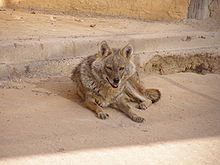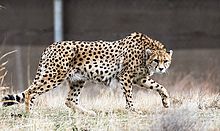Wildlife of Iran
The wildlife of Iran include the fauna and flora of Iran.
One of the most famous animals of Iran is the critically endangered Asiatic cheetah (Acinonyx jubatus venaticus), which today survives only in Iran.[1]
History
The animals of Iran were described by
Flora
More than one-tenth of the country is forested. The most extensive forest is found on the mountain slopes rising from the Caspian Sea, with stands of
- Caspian forestsof the northern districts (33,000 km2)
- Juniperusforests, 13,000 km2)
- Pistachio forests in the eastern, southern and southeastern districts (26,000 km2)
- Oak forests in the central and western districts (100,000 km2)
- Shrubs of the Dasht-e Kavir districts in the central and northeastern part of the country (10,000 km2)
- Hara forests.
More than 8,200 plant species are grown in Iran. The land covered by Iran's natural flora is four times that of the Europe's.
-
Persian ironwood is native to Northern Iran, but is widely planted elsewhere for aesthetic purposes
-
Fritillaria imperialis of Iran
-
The 4000-year-oldCypress of Abarqu, in Abarkuh
-
Juniperus excelsa polycarpos or Persian juniper
-
Avicennia marina trees (locally known as harra) of the mangrove forests of Qeshm
-
Trees in forests of Mazandaran
Fauna

Iran's living fauna includes 34 bat species, Indian grey mongoose, small Indian mongoose, golden jackal, Indian wolf, foxes, striped hyena, leopard, Eurasian lynx, brown bear and Asian black bear.[2] Ungulate species include wild boar, urial, Armenian mouflon, red deer, and goitered gazelle.[4] Domestic ungulates are represented by sheep, goat, cattle, horse, water buffalo, donkey and camel. Bird species like pheasant, partridge, stork, eagles and falcons are also native to Iran.[citation needed]
-
Camels in Kavir National Park
-
Syrian brown bear (Ursus arctos syriacus) in Lar National Park, northern Iran
Endangered


As of 2001, 20 of Iran's mammal species and 14 bird species were endangered. Endangered species in Iran include the
Extinct
- Aurochs (unknown date).
- The Syrian elephant roamed southern Iran, before vanishing there in ancient times.[7]
- The
- The Union of Soviet Socialist Republics, before 1960. The last tiger in Iran was reportedly sighted in Golestan National Park in 1958.[9][4][2]
-
Sasanian Empire relief of boar-hunting on domestic elephants, Taq-e Bostan, Iran
-
Men with a live lion in Persia, photographed by Antoin Sevruguin (1830s – 1933)
-
Rhinoceros in Iran, 1670s. Drawing by Jean Chardin
-
Caspian tiger killed in northern Iran in the early 1940s
See also
- List of birds of Iran
- List of mammals of Iran
- List of non-marine molluscs of Iran
- World Network of Biosphere Reserves in Asia and the Pacific
- List of national parks and protected areas of Iran
- Geography of Iran
- Environmental issues in Iran
- International rankings of Iran
- Wildlife of Afghanistan
- Wildlife of South Asia
- Wildlife of Iraq
References
- . Retrieved 13 November 2021.
- ^ ISBN 978-1-85043-946-2.
- ^ "Unasylva - Vol. 8, No. 2 - The work of FAO". Fao.org. Retrieved 6 January 2018.
- ^ ISBN 0-9513977-6-1.
- ^ "74 Iranian wildlife species red-listed by Environment Department". Payvand.com. Retrieved 6 January 2018.
- ^ Sanei, A., Zakaria, M., Hermidas, S. (2011). Prey composition in the Persian leopard distribution range in Iran. Asia Life Sciences Supplement 7: 19–30.
- ^ Choudhury, A.; Lahiri Choudhury, D.K.; Desai, A.; Duckworth, J.W.; Easa, P.S.; Johnsingh, A.J.T.; Fernando, P.; Hedges, S.; Gunawardena, M.; Kurt, F. (2008). "Elephas maximus". IUCN Red List of Threatened Species. 2008: e.T7140A12828813.
- ^ Khosravifard, S.; Niamir, A. (2016). "The lair of the lion in Iran". Cat News (Special Issue 10): 14−17.
- ^ Geptner, V. G.; Sludskij, A. A. (1992) [1972]. "Tiger". Mlekopitajuščie Sovetskogo Soiuza. Moskva: Vysšaia Škola [Mammals of the Soviet Union. Volume II, Part 2. Carnivora (Hyaenas and Cats)]. Washington DC: Smithsonian Institution and the National Science Foundation. pp. 95–202.
External links
- Fauna of Persia, Encyclopædia Iranica
- Department of Environment of Iran
- Asian Leopard Specialist Society, Iran: Research, Conservation and Management
- Flora of Iran by Pr Ahmad Ghahreman
- Flora of Iran
- Iranian Cheetah Society (ICS)
- Status of the Persian Leopard in Iran
- Skin of a Persian lioness, belonging to an endangered subspecies of lions, brought to Dublin by King Edward VII in 1902.














